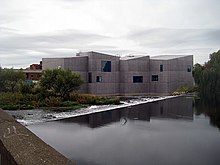Wakefield
Wakefield became an important market town and centre for wool, exploiting its position on the navigable River Calder to become an inland port.Flint and stone tools and later bronze and iron implements have been found at Lee Moor and Lupset in the Wakefield area showing evidence of human activity since prehistoric times.[11] After the Conquest Wakefield was a victim of the Harrying of the North in 1069 when William the Conqueror took revenge on the local population for resistance to Norman rule.The settlement was recorded as Wachfeld in the Domesday Book of 1086, and covered a much greater area than present day Wakefield, much of which was described as "waste".[18] The Saxon church in Wakefield was rebuilt in about 1100 in stone in the Norman style and was continually enlarged until 1315 when the central tower collapsed.[21] During the Wars of the Roses, Richard Plantagenet, Duke of York was killed on 30 December 1460 in the Battle of Wakefield near Sandal Castle.In 1538 John Leland described Wakefield as, "a very quick market-towne and meately large; well served of flesch and fisch, both from the se and by rivers, whereof divers be thereabout at hande, so that al vitaile is very gode chepe there.[23] In 1699 an Act of Parliament was passed creating the Aire and Calder Navigation which provided the town with access to the North Sea.Large warehouses were built on the river banks to store grain from Norfolk, Cambridgeshire and Lincolnshire to supply the fast-growing population in the West Riding of Yorkshire.Great quantities of barley were grown in the neighbourhood and in 1885 more malt was made in Wakefield "than in any district of equal extent in the kingdom".During the 19th century, the Wakefield Asylum played a central role in the development of British psychiatry, with Henry Maudsley and James Crichton-Browne amongst its medical staff.[36] Wakefield Mechanics' Institute containing an Assembly Room, public library and newsroom supported by subscription was built in Wood Street in 1820–1821 in the Classical style with Ionic details.[42] There are seven ex-council estates in Wakefield which the council started to build after the First World War, the oldest is Portobello, the largest is Lupset and the rest are Flanshaw, Plumpton, Peacock, Eastmoor and Kettlethorpe.Homes not bought by occupants under the Right to Buy scheme were transferred to a registered social landlord, Wakefield and District Housing (WDH) in 2005.[61] He announced three days after his conviction that he would be resigning as an MP, and left his post on 3 May, triggering the 2022 Wakefield by-election,[62][63] which was held on 23 June and won by Labour's Simon Lightwood.The Wakefield South ward covering Sandal, Kettlethorpe, Agbrigg and Belle Vue, is in the Hemsworth constituency, represented by the Labour party's Jon Trickett since 1996.Wakefield is within the area of the Nottinghamshire, Derbyshire & Yorkshire coalfield and lies on the middle coal measures and sandstones laid down in the Carboniferous period.[68] Wakefield includes the former outlying villages of Alverthorpe, Thornes, Sandal, Portobello, Belle Vue, Agbrigg, Lupset, Kettlethorpe and Flanshaw.[citation needed] The number of theft-from-a-vehicle offences and theft of a vehicle per 1,000 of the population was 7.9 and 3.9 compared to the English national average of 6.3 and 2.3 respectively.[88] Developments by the river and canal, the "Wakefield Waterfront", include the refurbishment of the Grade II listed Navigation Warehouse and office, retail, restaurant and cafe units.[90][91] Other landmarks in the Civic Quarter on Wood Street include the Grade II*Neoclassical Crown Court of 1810,[92] Wakefield Town Hall designed by T.E.The old Wakefield Bridge with its Chantry Chapel, Sandal Castle, and Lawe Hill in Clarence Park are ancient monuments.It has connections to the East Coast Main Line, trains to Leeds, Doncaster, and stations towards London King's Cross.East Midlands Railway also run a limited service via Sheffield, Derby and Leicester to London St Pancras.[111] Wakefield College has its origins in the School of Art and Craft of 1868[112] and today is the major provider of 6th form and further education in the area, with around 3,000 full-time and 10,000 part-time students,[113] and campuses in the city and surrounding towns.In July 2005 a sculpture was erected to celebrate this facet of Wakefield, and there is an annual 'Wakefield Festival of Food, Drink and Rhubarb" which takes place over the last weekend in February.[150] The 1963 film This Sporting Life starring Richard Harris, Rachel Roberts, William Hartnell and Arthur Lowe was partially filmed in Wakefield, specifically at Wakefield Trinity Rugby Ground, Belle Vue, the area around the top of Westgate and the demolished "Locarno Night Club" – Southgate, now the Cathedral entrance to Ridings Shopping Centre.However, fortunes soon declined with supporters abandoning the club and they moved out of Belle Vue, first to College Grove and then briefly to share with Ossett Town, ultimately, Wakefield FC folded in June 2014[155] with crowds in the low double figures by then.was formed by a consortium including former professional player Chris Turner and played in the Sheffield & Hallamshire County Senior Football League, in 2021 the club was bought by VO2 capital.[165] Thornes Park Athletics Stadium is home to Wakefield Harriers A.C. Members Martyn Bernard and Emily Freeman competed in the Beijing Olympics.













Wakefield (disambiguation)Town HallCathedralPugneys Country ParkWest YorkshireDensityOS grid referenceLondonMetropolitan boroughCity of WakefieldMetropolitan countyRegionYorkshire and the HumberCountryEnglandSovereign stateAgbriggAlverthorpeBelle VueCarr GateEastmoorFlanshawLupsetNewmillerdamOutwoodSandal MagnaPost townPostcode districtWF1-WF4Dialling codePoliceAmbulanceYorkshireUK ParliamentWakefield and RothwellOssett and Denby Dalecathedral cityRiver Calder2021 census2011 censusMetropolitan Borough of WakefieldWest Yorkshire Built-up Areaits cathedralcounty hallcounty boroughmetropolitan boroughcounty townWest Riding of YorkshireBattle of WakefieldWars of the RosesRoyalistCivil Warmarket towninland portOld EnglishDomesday BookbronzeBrigantesPontefractKirkleesManchesterWakefield BridgeLingwell Gate coin mouldsAnglesVikingswapentakesWapentake of AgbriggWestgateNorthgateKirkgateEdward the ConfessorWilliam the ConquerorBattle of HastingsConquestHarrying of the Norththe crownWilliam de Warenne, 1st Earl of SurreySandal CastleWakefield CastleCheshireLancashirefeudalNormanWilliam de Warenne, 5th Earl of SurreyKing JohnAll SaintsHenry IIIarcheryMiddle AgesDuke of YorkRichard Plantagenet, Duke of YorkmedievaltanningJohn LelandSpanish ArmadaMorleyThomas FairfaxParliamentariansLieutenant-General GoringAire and Calder NavigationNorth SeaGeorgianAire and CalderCalder and Hebble NavigationsBarnsley CanalNorfolkCambridgeshireLincolnshireturnpikedmail coachesSheffieldcoaching innKirkgate stationManchester and Leeds RailwaybreweriessloopsNational Coal BoardWest RidingWakefield Court HouseWest Riding Pauper Lunatic AsylumHenry MaudsleyJames Crichton-BrowneWakefield PrisonWakefield Mechanics' InstituteClassical stylereservoirs

